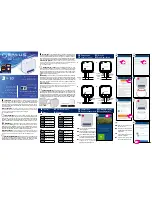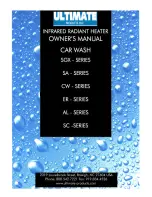
Page 35
4.2.2 Main Fan
Remove dust and other foreign matter by blowing off with compressed air or through the use of a soft bristle brush.
Check that the bearings do not show signs of excessive wear. It should be noted that these bearings do not require
lubricating.
4.2.3 Heat Exchanger
The heat exchanger requires a visual inspection at least once per year, this should be accompanied by cleaning.
It is recommended that a flue brush and vacuum cleaner be used to facilitate this.
Access to the heat exchanger is gained through the removal of the rear fan, front louvres and opening the access
door.
Servicing and cleaning should be performed as follows:
(a) Remove brass nuts and cover from heat exchanger end assembly to expose heat exchanger tubes.
(b) Remove any accumulated deposits from the tubes by pushing through the full length with a flue brush.
(c) The flue brush should be withdrawn so as to pull any deposits back into the bottom of the flue box where they can then be removed by
using a vacuum cleaner.
(d) Particular attention should be paid to the upper internal surfaces of the tubes, where through convection heavier deposition is likely to
occur.
(e) Any deposits which may have accumulated within the combustion chamber can be removed with a vacuum cleaner once the burner is
removed.
It is most important that a build up of deposits is not allowed to occur as this can have an adverse effect upon
the efficiency of the heater and reduce the life of the heat exchanger.
(f) The heat exchanger and combustion chamber should be visually inspected for signs of splits, cracks, and distortion.
(g) All gaskets should be checked to ensure that they continue to provide a gas tight seal, if there is an element of doubt then they should be
replaced.
If the condition of the heat exchanger gives cause for concern the suppliers Service Department should be advised
pending a more detailed examination. Details on rear page
4.2.4 Electrical Supply
All connections must be checked to ensure that they are secure, and free from corrosion.
Terminals and connections should also be checked to ensure that no stray strands are bridging terminals.
Electrical continuity should also be checked.
4.2.5 Oil Supply
The oil supply pipe work, tank, and fittings should all be inspected to ensure that they are free from corrosion, and to
ensure that where brackets have been fitted these remain secure and offer adequate support.
The oil filter should be replaced with a new one, and the system should be checked for leaks. If the oil level is such to
allow removal of any sludge or other contaminants form the tank this too should be undertaken, particularly if there
have been problems of poor firing associated with contaminants reaching the burner.
WARNING
Any waste oil or sludge must be disposed of correctly. Never dispose of it by dumping or tipping it down drains
or into watercourses where ground water can become polluted and environmental damage caused.
Summary of Contents for OUH 100
Page 46: ...Page 46 Notes...














































